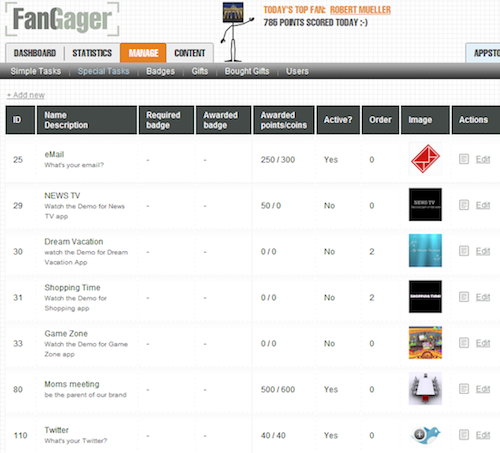At the beginning of my call with Eran Gefen, CEO of NYC-based, FanGager, we talked about how CRM 2.0, and even social CRM are not particularly appropriate labels to describe his company.
FanGager software lets businesses measure the frequency of wall posts, tweets, likes, and other social interactions, as well as visitors engaging with surveys, trivia questions, and actual games, like collecting virtual cupcakes.
And FanGager does, ahem, measure and reward customers who actually purchase products.
FanGager is an environment, a platform to be blunt, which can be configured and molded by marketers. There’s a FanGager store from which to choose turn-key interactive apps to embed into corporate web sites. For developers, especially those in digital agencies, there are APIs for creating monitorable game features in Flash apps.
So we’re pretty far afield from SalesForce.com and other CRM-ish apps, or even those CRM 2.0 environments with a dash of Twitter monitoring added.
As Gefen kept on reminding me during the call, it’s about value: value the customers create for you, and you create for customers.
Taking just one side of the value equation, value of the customers, Gefen steered me to a report FanGager publishes each month listing Facebook’s 100 top engaged brands. FanGager’s web crawling software learns not only which brand has the most fans, but also the number of those fans who are actively posting, commenting, and generally clicking and typing on a FaceBook fan page.

FanGager reports on fan engagement levels.
The latest report on their website shows that Texas Hold’em Poker’s fan page has reached the number 1 slot with the most fans (over 44 million), displacing Justin Bieber, who led the pack back in March. No comment on my part.
Gefen than pointed out the really significant performance measurement is the percentage of active fans. By that yard stick, Bieber, at around 272,000 active fans or .9%, beats out Hold’em, with only .7%.
So what is FanGager all about? Says Gefen: “Taking this number of 1% [active fans] and making it 10%. We have the ability to create engagement in the long term … creating value to the fan and the brand.”
Gefen took me on a quick tour of the platform, revealing FanGager’s huge assortment of probes and sensors to measure interactions and other game mechanics, and then set up appropriate rewards.
The scope here is quite broad as to what can be monitored, including video interactions.
While I’ve seen some of these ideas in startups that I’ve written about over the last year, the likes of innovid, ThingLink, Turnto, the former Bantam Live, and a few hackathon projects, but none of these touched all the bases.
So gold stars and bonus points to FanGager for squeezing it all into one package.
It’s a platform that should be quite appealing to large businesses. And in fact, FanGager counts American Express Cards in Israel, Nokia, and the Big Brother TV show (the Israeli version I think) as clients.
After the demo was over, I was pondering active engagement as a performance metric and my mind wandered back to a pre-social media metric that still holds sway in many large companies. Remember Reichheld’s net promoter score (NPS) and “the ultimate question”—that is, would you recommend this product to a friend?
There’s still is a lot of controversy over whether this simple assessment of customer engagement correlates with customer loyalty, and ultimately repeat purchases and revenue.
I am absolutely sold on the principle that those customers who are tweeting, commenting, and helping others are boosting a company brand, and believe that the percentage of active fans is a much more interesting metric than NPS.
But I’m little concerned that rewarding those fans with digital trinkets may reinforce behaviors that result in more game playing, rather than the ultimate measurement, more sales.
Gefen does make the important point that, outside of raw ROI, there’s lots of marketing value in having active fans, especially in terms of spreading your company’s content. True enough.
As with most marketing strategies, it’s up to the marketers themselves to use the FanGager force wisely in choosing what they reward.
Related articles
- FanGager
- 100 Top Engaged Fans on Facebook (fangager.com)
- Fun With ThingLink (technoverseblog.com)
- Five of Our Favorite Small Business Apps (technoverseblog.com)



